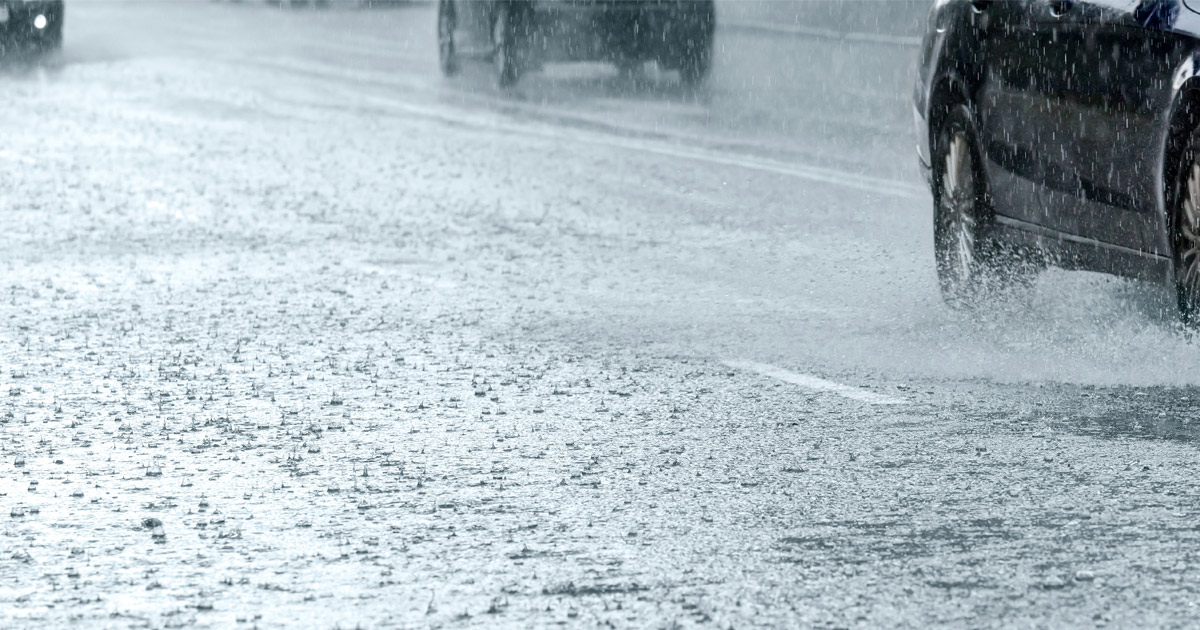Hydroplaning happens when tires come into contact with more water than they can slough off, and it can be quite dangerous. Tires have grooves (treads), which are made to channel water out to the sides instead of underneath in order to create more friction with the road.
When hydroplaning, water pressure at the front of the car’s wheel pushes water under the tire and too much of it causes the tire to separate from the road’s surface. This results in a loss of traction, braking, steering, and control. It can be extremely frightening, but knowing how to prevent hydroplaning and understanding how to react when it happens will prevent a serious car accident.
Being aware of the situations that can cause hydroplaning is the first step. While it can happen on any wet road, the first 10 minutes during a light rain are probably the most hazardous. As rain mixes in with oil residues on the road, it becomes slippery. When people are driving more than 35 miles per hour in these conditions, the risk of hydroplaning increases even more. This is one reason why it is important to slow down when it starts to rain; the faster one drives, the harder it is for their tires to disperse the water.
Keeping your tires maintained can also prevent hydroplaning. Be sure that they are properly inflated. Many vehicles now have warning systems that show alerts when the pressure is too low or too high. In most cases, tires should be balanced and rotated every 7,000 to 10,000 miles. Inspect your tires regularly, check the tire pressure, and never drive on bald tires. Rotate and replace them when necessary, and do not procrastinate if repairs are needed.
When driving in poor weather conditions, your goals are to see other vehicles and to be seen by their drivers. All of your headlights, taillights, turn signals, and brake lights should be in good working order. If your windshield wipers are leaving streaks or not clearing the windshield, you should get new ones. Also, remember to keep your headlights on whether it is daytime or nighttime.
If you are driving in wet weather, keep away from standing water and puddles; you can hydroplane when driving through these as well. If someone is in front of you, drive in their tire tracks if you can, and stay away from the outer lanes because this is where water can accumulate. Drive in a lower gear, turn off the cruise control, and avoid braking too hard. Do not make sharp or quick turns.
You should increase your following distance and avoiding all distractions. Put your phone on Do Not Disturb mode, keep both hands on the wheel, and stay focused at all times.
Also, be aware that other vehicles will go through large puddles and standing water, which can cause sheets of water to splash onto your windows. This can impair your visibility for several seconds.
How Do I Know if I am Hydroplaning?
Hydroplaning is less obvious than a skid. It often feels “loose” beneath your vehicle due to it making less contact with the road. The steering may be less responsive as well. If possible, you can check your rear-view mirror and see if there are dry tracks in the water from your tires. This is where they make contact with the road, so if you do not see any, you are most likely hydroplaning.
Hydroplaning can happen quickly. Defensive driving can lessen the chances of this happening. You should not brake suddenly or turn suddenly when hydroplaning. Either action can force your vehicle to skid.
With traction control and anti-lock braking systems (ABS), look for an open space ahead of you and apply light pressure to the accelerator. Then, gently steer toward that open space, slow down, and stop the car. If you have rear-wheel drive that does not have traction control or an ABS, look for an open space, ease off the accelerator, and slowly steer.
You will most likely need to make small steering corrections, but do your best to keep the vehicle going straight and forward. Sharp steering corrections can make your vehicle swerve into another lane, car, or truck. Keep in mind that you are actually gliding over water, and your control is very limited. If you do start to hydroplane, try to remain calm and slowly steer into the skid. This can help your tires realign in the direction that the car is going.
What Should I Do After a Hydroplane Accident?
Any type of car accident can be overwhelming or frightening. If another vehicle was speeding, started hydroplaning, and crashed into you, you may have serious injuries. Make sure that everyone, including yourself, is okay, and call for emergency services.
While waiting for help to arrive, you might want to exchange information with the other driver if you feel safe enough to do so. Take pictures of any injuries, all the vehicles involved, and the accident scene. You should also photograph the poor weather conditions.
Reach out to your auto insurance provider as soon as you can, and be fully cooperative with them. Do not provide too many details or admit guilt because they might decide to use this information against you later.
Seek medical treatment as soon as possible, even if you believe your injuries are minor. Many symptoms of injuries take time to show up, so it is best to get checked out right away. Also, keep records of your diagnosis, treatment, and all related expenses, as this information may be needed for evidence.
Virginia Beach Car Accident Lawyers Can Help You Explore Your Legal Options After a Hydroplane Accident
If you have been injured in a hydroplane accident due to the negligence of another driver, reach out to one of our skilled Virginia Beach car accident lawyers. You will find trusted legal guidance at East Coast Trial Lawyers. Call us at 757-352-2237 or contact us online to schedule a free consultation. Located in Virginia Beach, we serve clients throughout Chesapeake, Eastern Shore, Hampton, Newport News, Norfolk, Portsmouth, and Suffolk, Virginia, as well as North Carolina and nationwide.


